What constitutes a ‘document’ and how does it function?
According to the Oxford English Dictionary, the etymological origin is the Latin ‘documentum’, meaning ‘lesson, proof, instance, specimen’. As a verb, it is ‘to prove or support (something) by documentary evidence’, and ‘to provide with documents’. The online version of the OED includes a draft addition, whereby a document (as a noun) is ‘a collection of data in digital form that is considered a single item and typically has a unique filename by which it can be stored, retrieved, or transmitted (as a file, a spreadsheet, or a graphic)’. The current use of the noun ‘document’ is defined as ‘something written, inscribed, etc., which furnishes evidence or information upon any subject, as a manuscript, title-deed, tomb-stone, coin, picture, etc.’ (emphasis added).
Both ‘something’ and that first ‘etc.’ leave ample room for discussion. A document doubts whether it functions as something unique, or as something reproducible. A passport is a document, but a flyer equally so. Moreover, there is a circular reasoning: to document is ‘to provide with documents’. Defining (the functioning of) a document most likely involves ideas of communication, information, evidence, inscriptions, and implies notions of objectivity and neutrality – but the document is neither reducible to one of them, nor is it equal to their sum. It is hard to pinpoint it, as it disperses into and is affected by other fields: it is intrinsically tied to the history of media and to important currents in literature, photography and art; it is linked to epistemic and power structures. However ubiquitous it is, as an often tangible thing in our environment, and as a concept, a document deranges.
the-documents.org continuously gathers documents and provides them with a short textual description, explanation,
or digression, written by multiple authors. In Paper Knowledge, Lisa Gitelman paraphrases ‘documentalist’ Suzanne Briet, stating that ‘an antelope running wild would not be a document, but an antelope taken into a zoo would be one, presumably because it would then be framed – or reframed – as an example, specimen, or instance’. The gathered files are all documents – if they weren’t before publication, they now are. That is what the-documents.org, irreversibly, does. It is a zoo turning an antelope into an ‘antelope’.
As you made your way through the collection,
the-documents.org tracked the entries you viewed.
It documented your path through the website.
As such, the time spent on the-documents.org turned
into this – a new document.
This document was compiled by ____ on 15.02.2022 14:10, printed on ____ and contains 15 documents on _ pages.
(https://the-documents.org/log/15-02-2022-3812/)
the-documents.org is a project created and edited by De Cleene De Cleene; design & development by atelier Haegeman Temmerman.
the-documents.org has been online since 23.05.2021.
- De Cleene De Cleene is Michiel De Cleene and Arnout De Cleene. Together they form a research group that focusses on novel ways of approaching the everyday, by artistic means and from a cultural and critical perspective.
www.decleenedecleene.be / info@decleenedecleene.be - This project was made possible with the support of the Flemish Government and KASK & Conservatorium, the school of arts of HOGENT and Howest. It is part of the research project Documenting Objects, financed by the HOGENT Arts Research Fund.
- Briet, S. Qu’est-ce que la documentation? Paris: Edit, 1951.
- Gitelman, L. Paper Knowledge. Toward a Media History of Documents.
Durham/ London: Duke University Press, 2014. - Oxford English Dictionary Online. Accessed on 13.05.2021.

At a dental practice, the white Alligat®-powder is mixed with the right amount of water to get a mouldable dough that is pressed upon a patient’s teeth. After thirty seconds, the Alligat®-dough stiffens and takes on a rubber-like quality. At that point, still white, it must be removed from the patient’s mouth. Over the next few hours, the mould turns increasingly pink as the substance becomes less humid. Now, it can be used as a mould to create a positive master cast of the patient’s teeth.
Outside the dental practice, the powder’s possibilities remain to be fully explored.

First published as part of De Cleene De Cleene. ‘Amidst the Fire, I Was Not Burnt’, Trigger (Special issue: Uncertainty), 2. FOMU/Fw:Books, 25-30
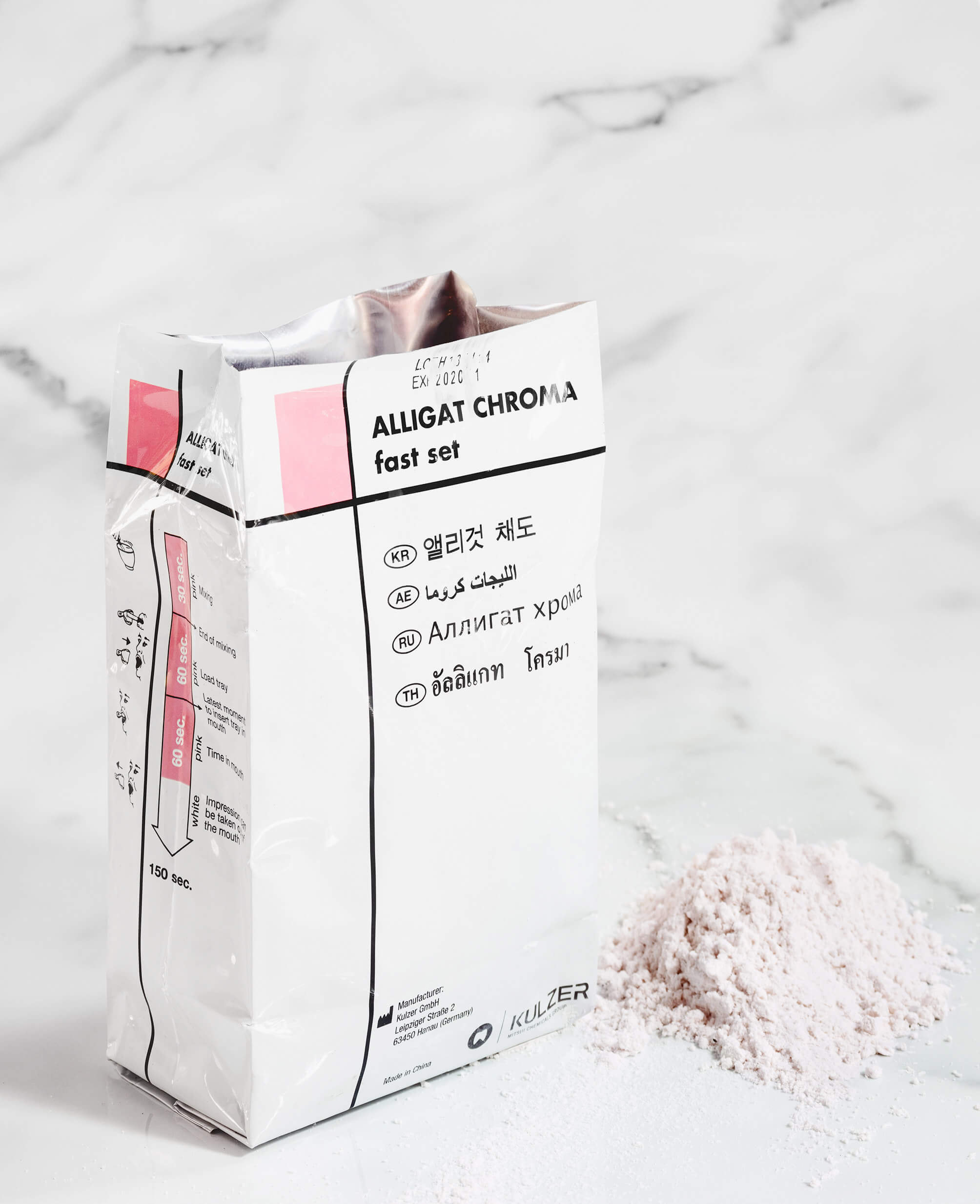
Where once there was twelve million cubic metres of water, excavators and trucks are moving dirt and rocks that have been hidden from sight for 56 years; piling them up into a temporary dam: a batardeau.

‘Because there is a kind of technological beauty to it.’
[…]
‘Yes, a perfect combination of the analogous on the one hand, and a kind of state of the art-futuristic cool on the other hand. It was elegant (unlike audio-cassettes), you could see the disc upon which your music was written (unlike the unfathomable MP3), it was less fragile than a CD(-R), and conveniently sized (you could hold it in the palm of your hand, slip it into your pocket). It had a kind of Mission Impossible-esque gadget feel to it. It had the aura of being permanently ahead of its time, but not in a far-fetched sci-fi kind of way. It was real.’
[…]
‘You mean the clicks. Yes, it had a sound of its own. A pleasant sound – the hard plastic hitting the hard plastic sleeve. The slidable, uhm, metal thing. The small read/write handle at the side. The small disc that was just a little bit loose. It – without being played – looked, felt and sounded like, like data, yes, like palpable data.’
[…]
‘Not any more.’
[…]
‘My uncle’s Elvis Costello This Year’s Model LP with way too little bass-sounds. Watching the detectives, to be precise.’
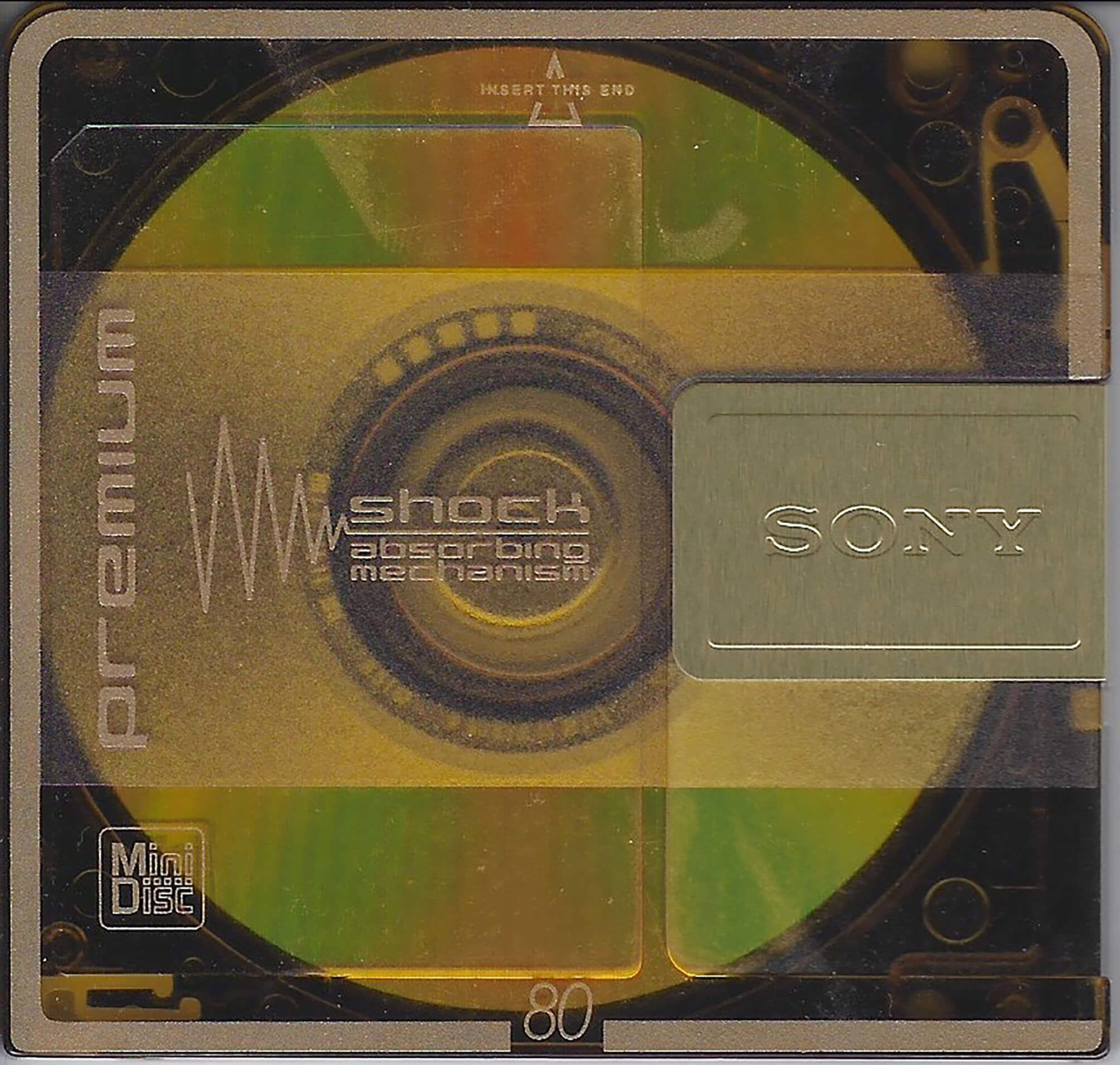
Fairly detailed map of the two major marble quarries on the island of Tinos, Greece. The spontaneous route-advice was prepared by a local marble worker, P.D., in the Karia region of the island on a locally extracted, green marble slab. The waved lines represent roads traversing uphill, while the straight lines represent roads following a contour line of the topography.
‘Tell your friend that the wine is for girls; it’s very sweet,’ the marble worker alerted my travel companion K.S. after offering us local sweet wine. The workshop smelled like boiled meat and bones.
Notes on map from left to right, top to bottom:
- Towards Vathi
- Quarry
- incomprehensible
- Towards Vathi Bleu
- Isternia
- Pirgos
Márk Redele pursues projects that fundamentally relate to architecture and its practice but rarely look like architecture. www.markredele.com

A cigar box, standing at the back of a shelf next to the heating installation, with in it silex-like stones with what seem to be traces of prehistoric usage.
In the garage, there were papers (the archive of O. Clemminck) and objects (stones, tiles) left to us by a man who had worked at the city archive. He was an acclaimed expert on our village’s history.1
A recent study by professor Philippe Crombé at Ghent University states that during the last Ice Age, in the region where I grew up, there was once a great lake, with, at the shores, proven presence of prehistoric man. As a kid, we dug up shells with a toothbrush, and set a perimeter with plastic tape. The former presence of a tavern where my parents now live, and the restaurant which still serves seafood at the other side of the road, prevented accurate dating.
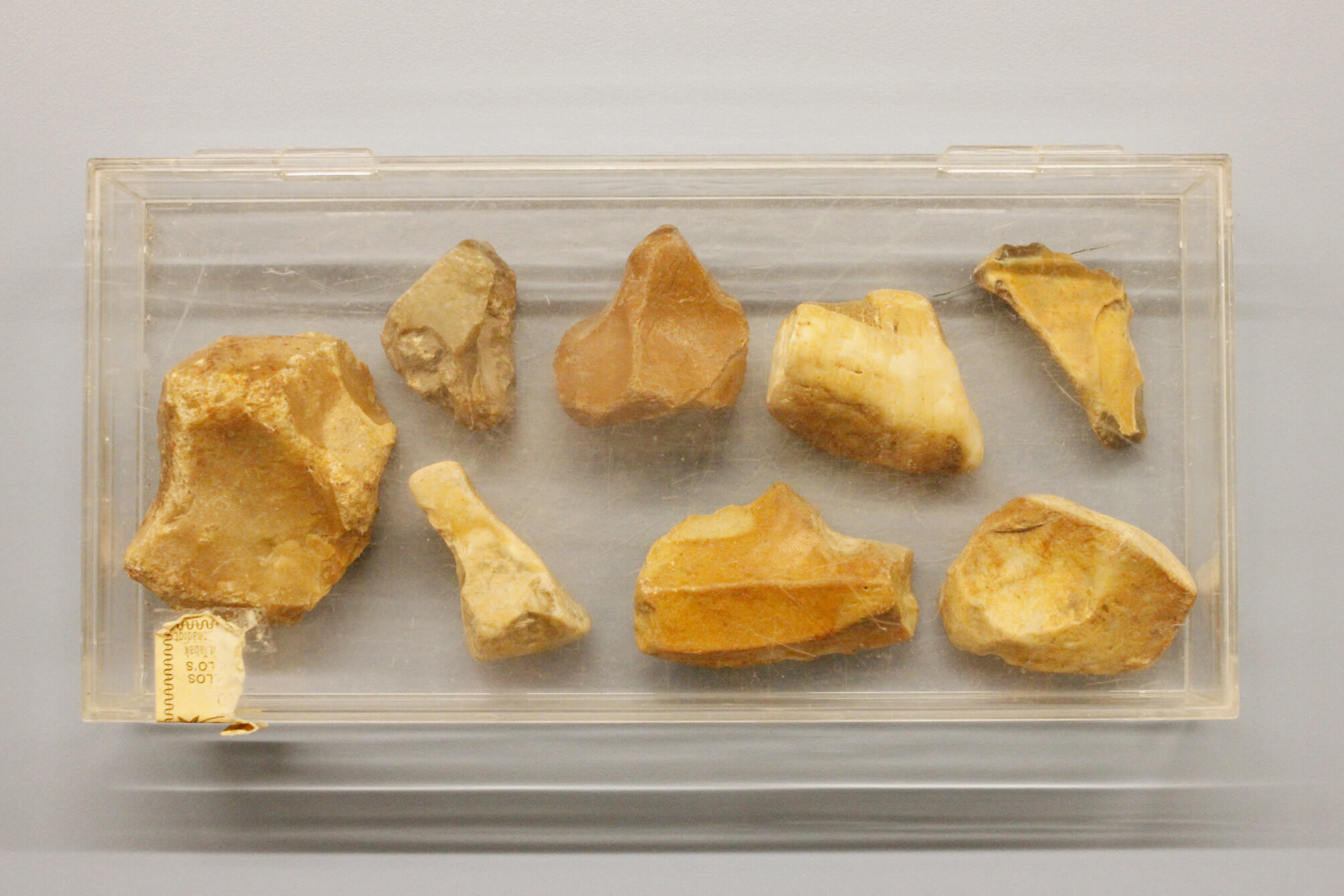
The previous owners of the house we moved into, left us a piece of a newspaper that was used to clad the wall at the time the building was built, and which they found when they renovated the house. The sport-section of the socialist newspaper Vooruit is dated 18 November 1931. It features articles on cycling and soccer. Recently, we noticed the plaster is coming off the wall in one corner of the living room. With sufficient rain, it might reveal other events that happened on that 1931 November Wednesday.

The oldest coin in the collection has darkened over time, but upon inspection, the text ‘AD USUM BELGII AUSTR’ (left) and the contours of a (female) head (right) can be discerned. A quick search learns it stems from the middle of the 18th century. The coin was made and used in the Austrian Netherlands, reigned by Maria Theresa, who is the one depicted. My mother recollects finding it in the backyard when she was a kid.
About 40 years later, the euro was introduced. The ringbinder with my mother’s coin collection was taken from the shelf. A dilemma came to the fore: we wondered if we should keep one of each existing Belgian coin and banknote and put them in the binder, alongside Maria Theresa, or if we should exchange them for the new European currency. The decision to keep a coin of five Belgian francs was not difficult to make, but as the amount raised, the answer was increasingly hard to give. This was an assessment of the old currency’s emotional and projected historical value, compared to its current financial worth. It was a decision based on investment principles.
To accentuate the value of the Maria Theresa kronenthaler of 1 liard, I put the coin on a pile of red post-it-notes when photographing it. Coins like these are sold on eBay for prices ranging from 0,70 euros to 16 euros.
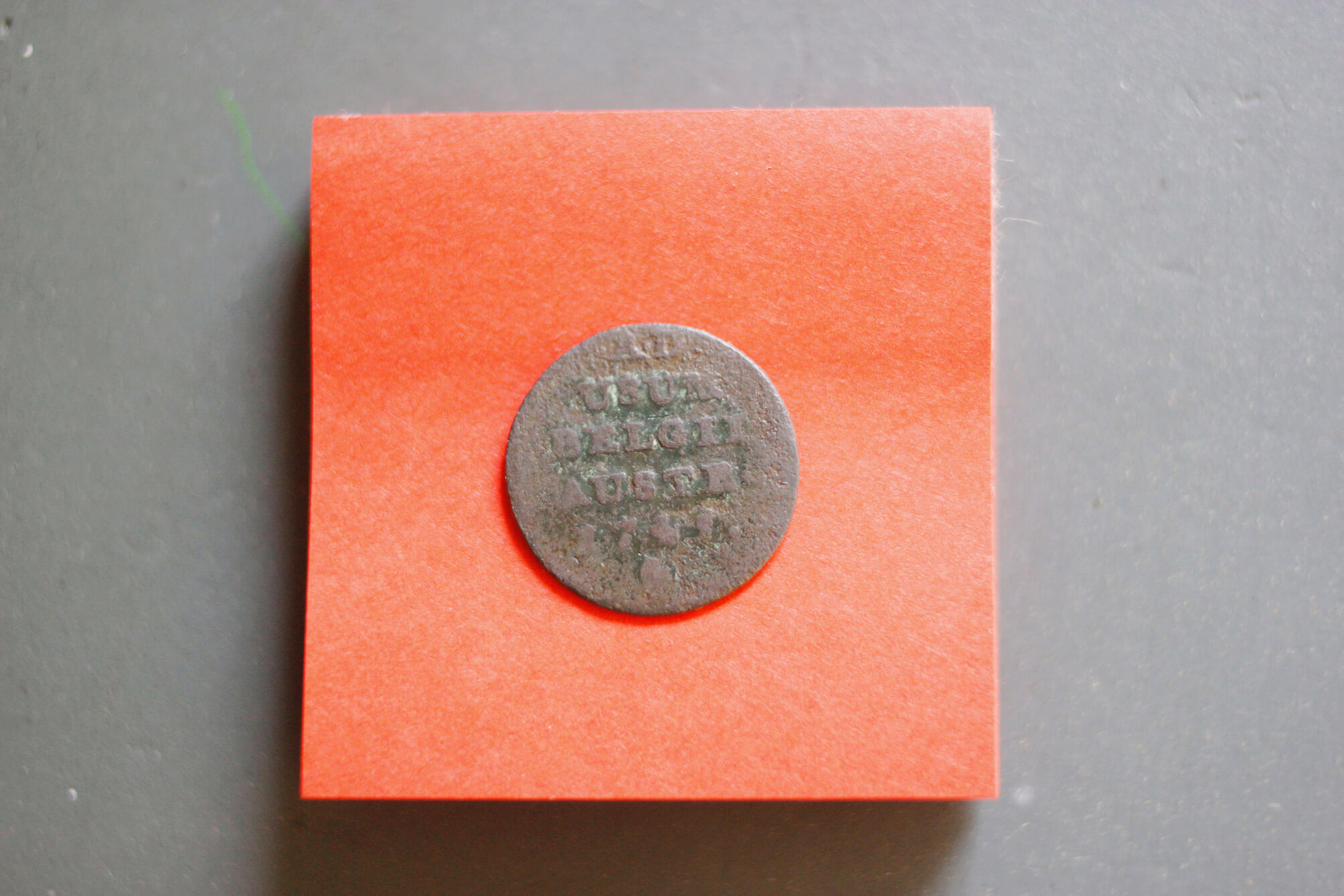

At the copyshop, on a shelf above photocopier 8, the lid of a box of paper serves as the container for ‘forgotten originals’.1
The book being copied: Didi-Huberman, G. La ressemblance par contact. Archéologie, anachronisme et modernité de l’empreinte. Paris: Les Editions de Minuit, 2008.
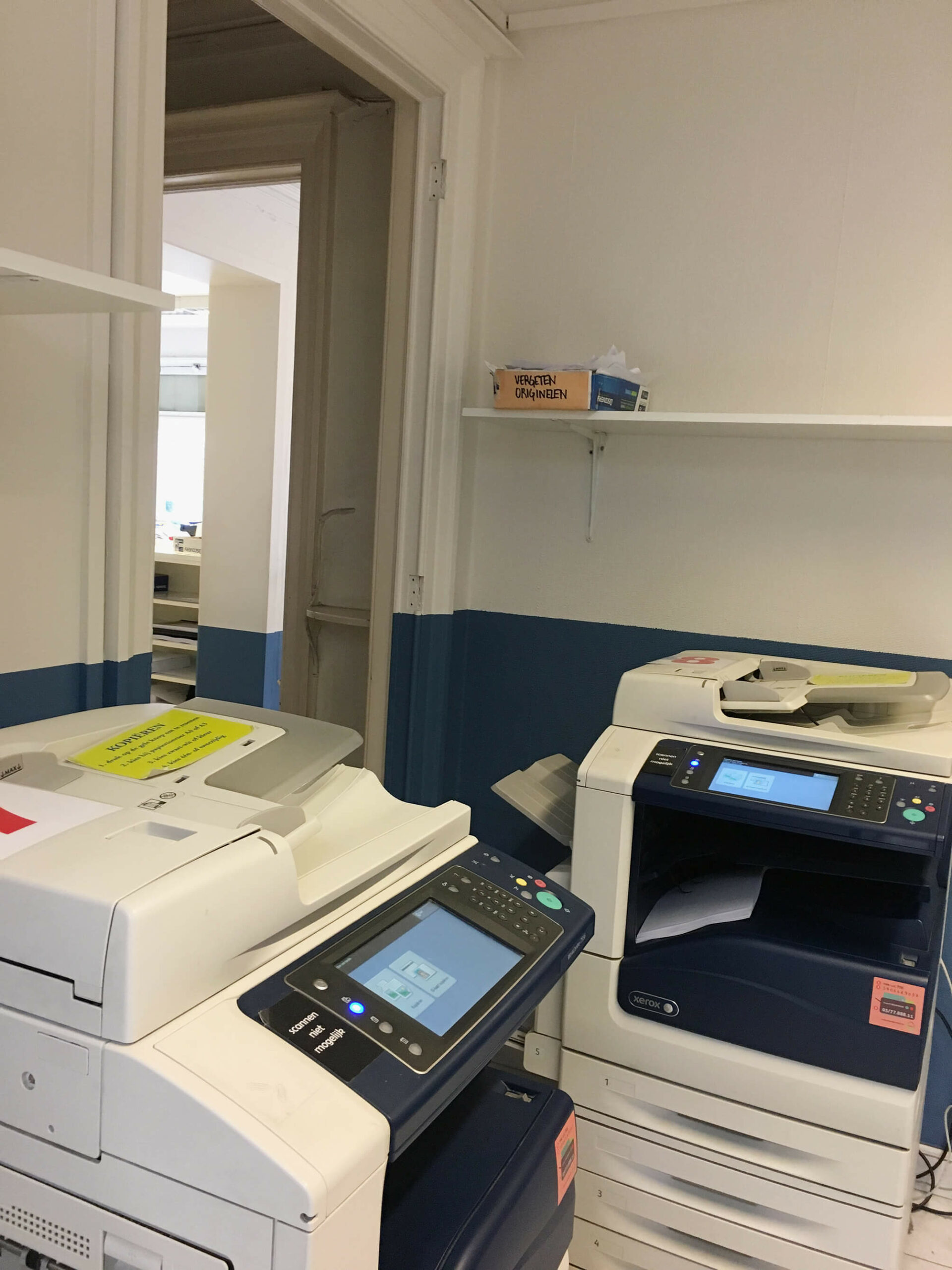
Depending on the language one chooses, the Wikipedia entry for ‘document’ shows a different picture. The French-language page shows what appears to be a Slovenian thesis written in 1984. The caption states it is a ‘book of Czechoslovak computer science author Květoslav Šoustal about computer networks’. The image was uploaded by Kelovy, a Slovakian mushroom-picker.
The anonymous hand rests on a lemon-yellow tablecloth, on which a yellow book and a blue binded file lie. The top left corner is the most intriguing, however: the tablecloth seems to be draped over a lemon, alongside a drinking glass. The cloth, however, does not get shaped by the lemon. Nor does the shadow-side of the lemon coincide with the shadow the other documents throw on the tablecloth. A closer look seems to indicate that the lemon is in fact an image of a lemon, printed on a plastic napkin.
The Russian wikipedia shows the image of a lease agreement. The German wikipedia for ‘document’ is text only.
https://fr.wikipedia.org/wiki/Document#/media/Fichier:KVETOSLAV_SOUSTAL_BOOK.JPG, created October 3, 2006 / original in original: paper, 1984

(‘Imaginary landscape in the actual greater Gent, some thousands of years ago. A grassy riparian zone separates rivers from the edge of the forests’)
Imagine a deserted city of Gent, overtaken by nature, Thiery asks the reader in his book Het woud (The Forest). After fifty years, you return to the city. Buildings have collapsed, streets are overgrown. It has become an impenetrable, dense forest, except for the river on which the reader makes his or her way through it. In the first half of the twentieth century, Leo Michel Thiery made one of Belgium’s first botanical gardens for educational purposes. In the middle of an industrialized quarter of the city of Gent, the garden presented different sceneries. There were landscapes from the Alps, dunes, the Ardennes, steppe. Besides sceneries with chalk-, loam-, marl- and sand-based vegetation, there were forests, grasslands and swamps.
After his death, Thiery’s garden decayed. Decades later, it was restored, with the Alps, dunes, the Ardennes and steppe now classified as a protected view.
Thiery, M. Het woud. Een proeve van plantenaardrijkskunde. Gent: De Garve, s.d., p. 14
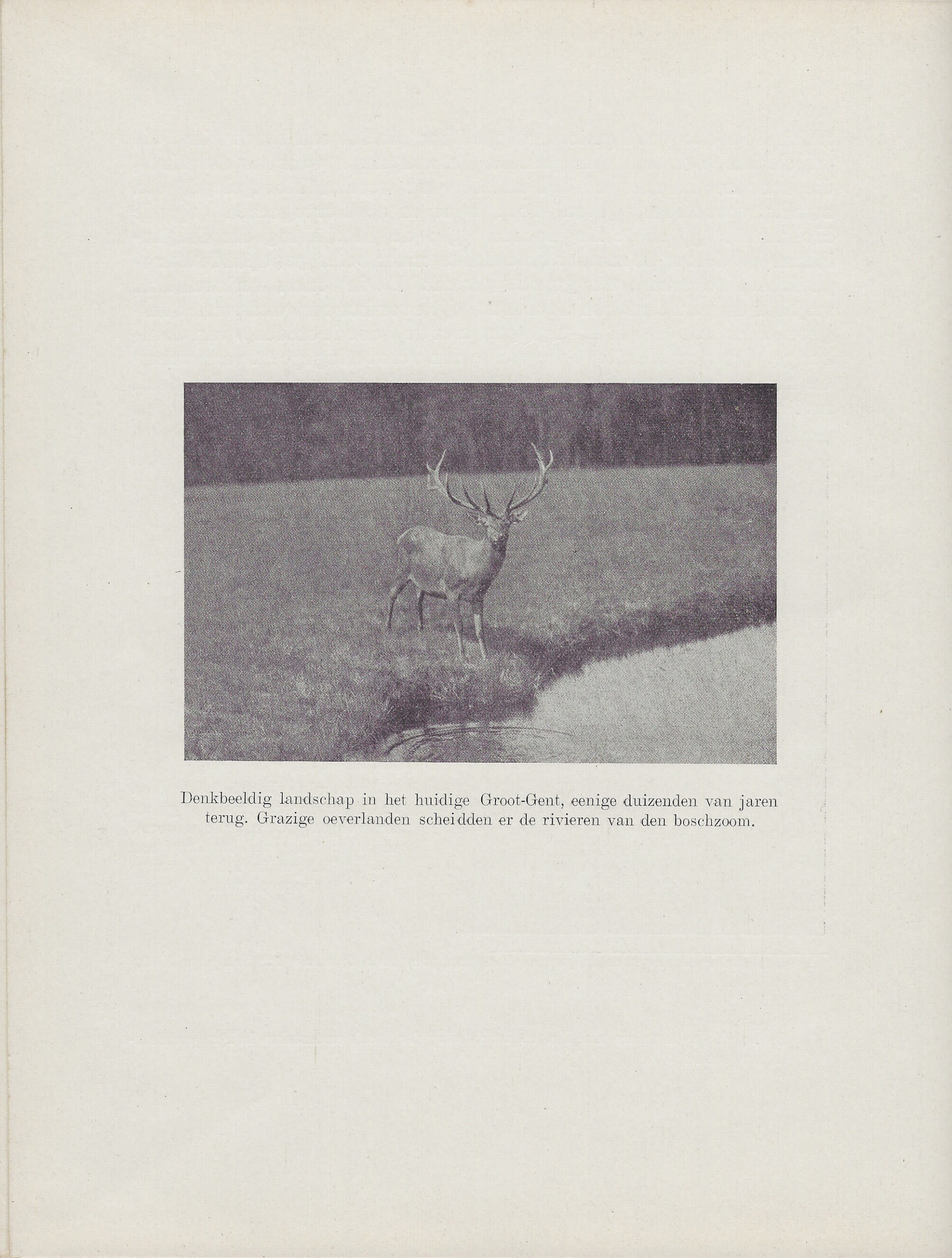
‘Because there is a kind of technological beauty to it.’
[…]
‘Yes, a perfect combination of the analogous on the one hand, and a kind of state of the art-futuristic cool on the other hand. It was elegant (unlike audio-cassettes), you could see the disc upon which your music was written (unlike the unfathomable MP3), it was less fragile than a CD(-R), and conveniently sized (you could hold it in the palm of your hand, slip it into your pocket). It had a kind of Mission Impossible-esque gadget feel to it. It had the aura of being permanently ahead of its time, but not in a far-fetched sci-fi kind of way. It was real.’
[…]
‘You mean the clicks. Yes, it had a sound of its own. A pleasant sound – the hard plastic hitting the hard plastic sleeve. The slidable, uhm, metal thing. The small read/write handle at the side. The small disc that was just a little bit loose. It – without being played – looked, felt and sounded like, like data, yes, like palpable data.’
[…]
‘Not any more.’
[…]
‘My uncle’s Elvis Costello This Year’s Model LP with way too little bass-sounds. Watching the detectives, to be precise.’

This is the spread one sees upon opening the bird field guide that once stood, as the stamp indicates, in the library of a psychiatric institution.1 It shows birds’ silhouettes, as they can be seen beside the road.
The drawing has a kind of Hitchcock feel to it.2 The birds seem to be spying on each other, as they also seem to be spying on the unsuspecting passer-by.
The composition of the scene is marvelous. The electric wires, the tree, the wire fence, the double framed list with the birds’ names, handsomely positioned in a birdless patch, at once superimposed on the telephone wires, and pushed to the background by the skylark.
Imagine seeing this scene. What are the odds: to see the silhouettes of Europe’s twenty most common species of birds in one glance, from your car’s window, as you are driving home at dusk.
Before closing the book, the last spread seems to show the birds fleeing, maybe attacking.3
The stamp indicates that, at the psychiatric institution, the book was part of the sublibrary for the Catholic Brothers of Charity. The crossed-out part indicates that there was also a separate physicians’ library, to which the book might have originally belonged.
On the web, discussions on whether Alfred Hitchcock’s The Birds (1963) was shot in colour or in black and white, abound.
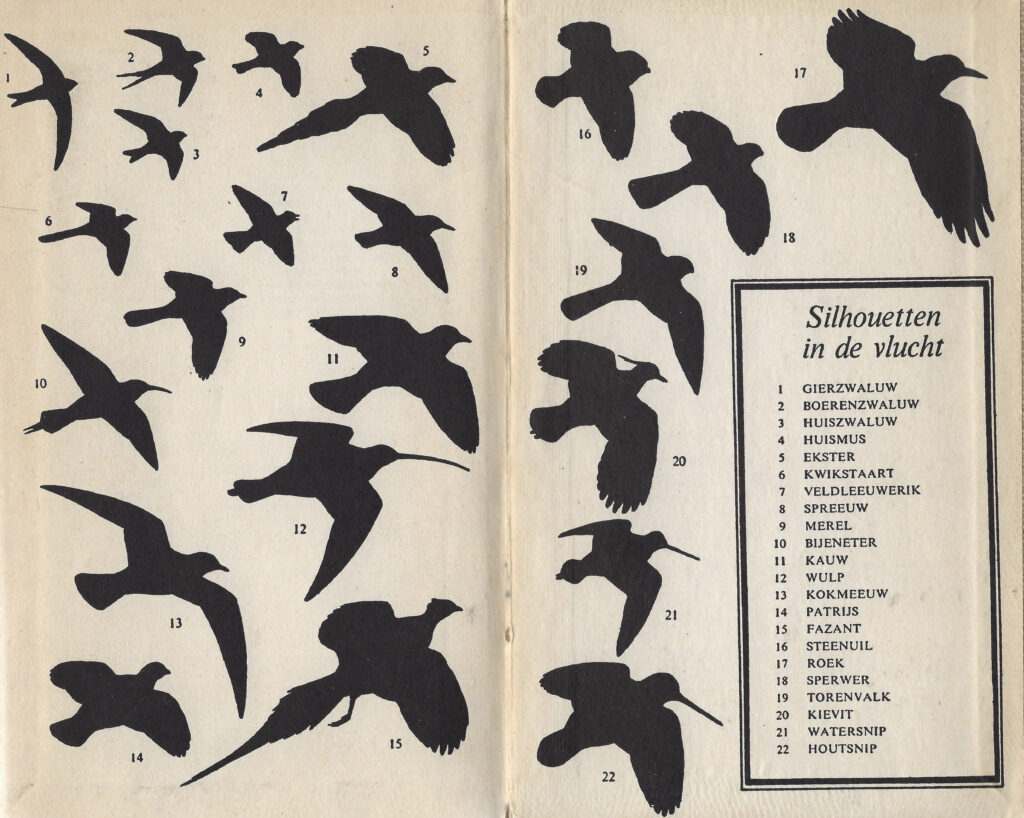
Peterson, R.T., Mountfort, G. & P.A.D. Hollom. Vogelgids voor alle in ons land en overig Europa voorkomende vogelsoorten (J. Kist, transl.). 3d ed. Amsterdam/Brussels: Elsevier, 1955.
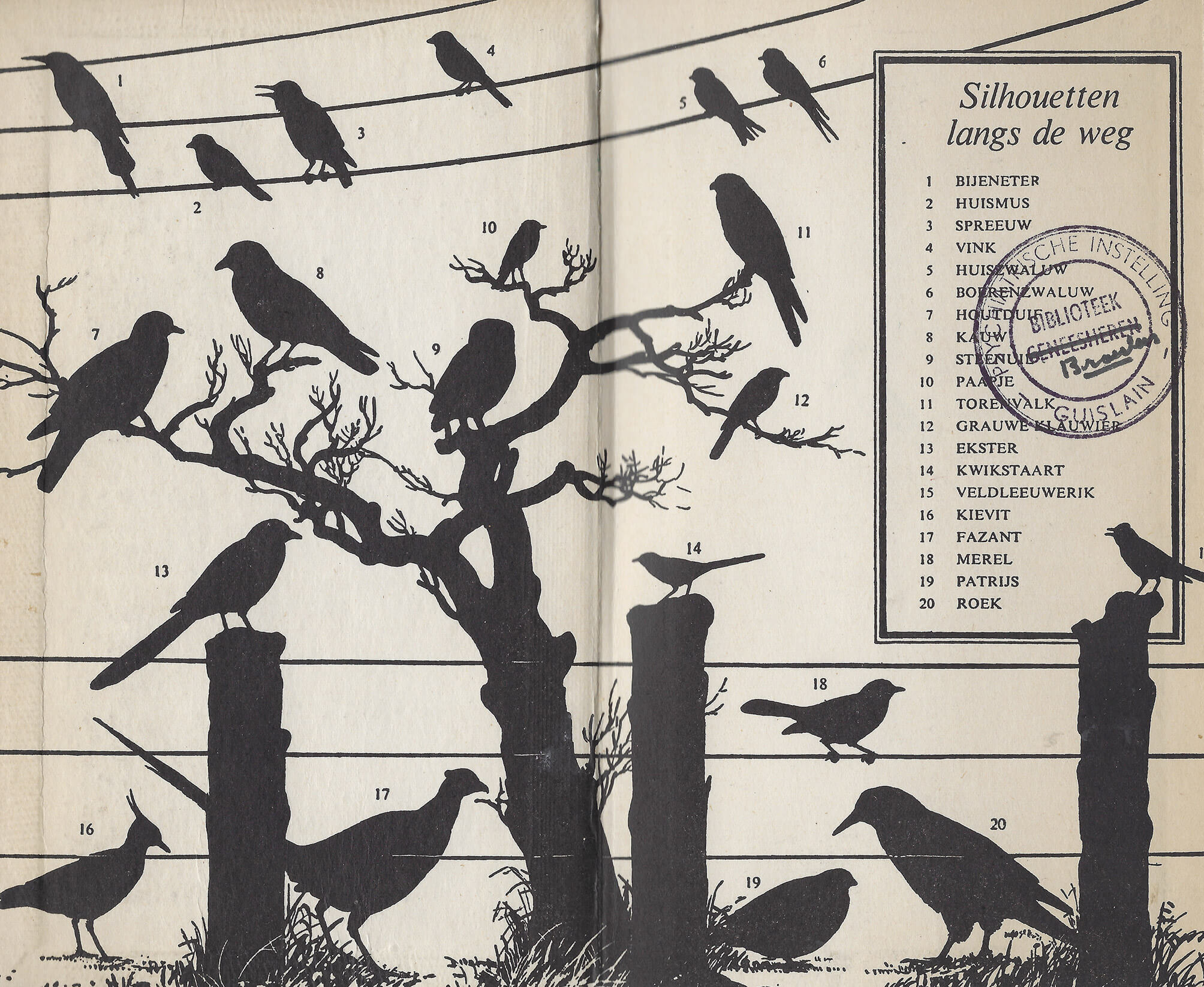
In between two cities along the Belgian coast, water has run from the dunes (and the Second World War Heritage site scattered among them), underneath the coastal road and tram rails, to the beach. It has formed a small S-shaped estuary, bound to disappear due to the increasingly harsh wind coming from the coast of Britain, blowing North-easterly, and hammering down on the levee. The vibrations of the empty Ostend-bound tram passing just before the photograph was taken, had no visible impact on the estuary.

Most mornings I eat three slices of bread. I stack them. Between the highest slice and the one in the middle I put a slice of cheese (young Gouda). I put the whole in the microwave1 for 1 minute and 50 seconds. The result is what I like to call a smelteram2.
On the morning of my thirty-second birthday the plate broke in half during heating.
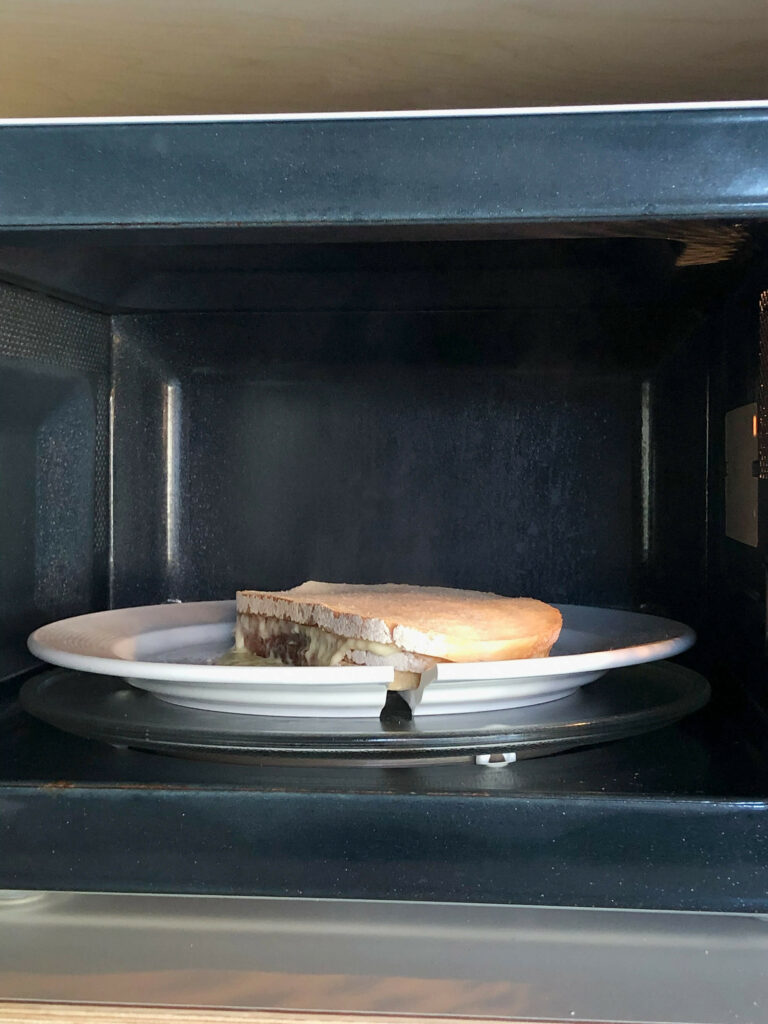
A contraction of smelten (Dutch for melting) and boterham (Dutch for a slice of bread).
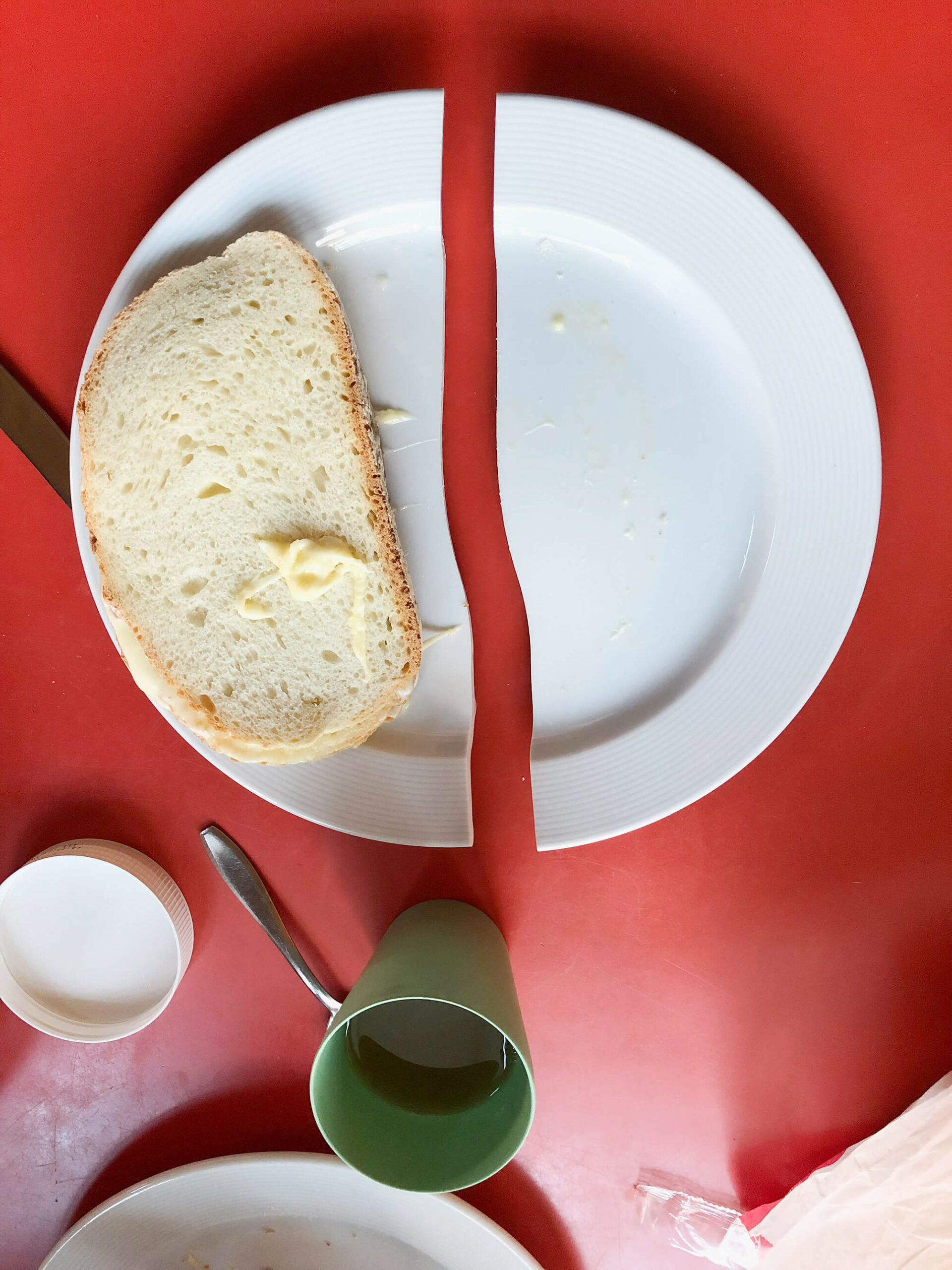
Shortly after crossing the Thur the couple reaches their car. They’re freezing. As the sun sets they drive through the mountainous landscape. The heating hurts their fingers.
The next day, they return, but the scene looks different. It’s warmer. The Thur appears to flow faster.
